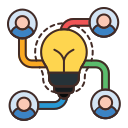Collaborative Tech Solutions for Distributed Teams
In today’s globalized economy, distributed teams are becoming the norm rather than the exception. Businesses of all sizes now rely on digital tools that foster real-time collaboration, enable effective communication, and streamline workflows across different time zones and locations. Collaborative tech solutions empower teams to remain productive and engaged, bridging the gap between remote employees and creating a unified virtual workspace. This guide explores the essential technologies, best practices, and strategies that help distributed teams thrive in a digital landscape.

Unified Messaging Solutions
Unified messaging solutions bring together chat, video calls, and audio conferencing into a single integrated interface. These platforms allow team members to communicate in real time, swiftly sharing updates, ideas, and feedback. By centralizing conversations, teams reduce the risk of losing important information and can archive discussions for future reference. Instant notifications and status indicators minimize delays and help maintain the pulse of ongoing projects. Tools with search capabilities further enhance productivity by making previous conversations easily accessible when needed, ensuring distributed teams operate smoothly and respond promptly to shifting priorities.
Video Conferencing Capabilities
For distributed teams, video conferencing bridges the gap between face-to-face interactions and remote work. These technologies enable effective meetings, virtual brainstorming sessions, and onboarding experiences, supporting both large town halls and intimate group discussions. High-quality audio and video feeds help maintain engagement levels by capturing facial expressions, tone, and mood—critical cues often lost in text-only exchanges. Advanced features such as screen sharing, live annotation, and recording make video calls versatile platforms for collaborative planning and documentation. As a result, video conferencing cements social bonds and cultivates a sense of presence despite the physical distance.
Asynchronous Communication Tools
While real-time messaging is essential, asynchronous communication tools are invaluable for distributed teams working across various time zones. Platforms that facilitate delayed conversations—such as forums, message boards, and thoughtfully designed project updates—empower team members to contribute on their schedules without interrupting workflow. Asynchronous tools build a knowledge base over time, making it easy to revisit discussions, clarify previous decisions, and onboard new colleagues efficiently. By reducing the pressure of immediate responses, these systems support deep work and encourage more considered, thoughtful contributions from each team member.

Cloud-Based Document Editors
Cloud-based document editors reinvent the way teams create and manage content together. Multiple users can draft, revise, and comment on documents simultaneously, eliminating version control headaches and speeding up feedback cycles. Every change is tracked in real time, offering transparency and accountability across all contributors. Built-in chat and notification features overlay collaborative editing sessions, so relevant stakeholders stay involved throughout the process. These editors are accessible from any device with an internet connection, ensuring that team members can collaborate effectively, regardless of their location or preferred hardware.

Secure File Sharing Systems
A secure file sharing system is vital for distributed teams handling sensitive information across diverse networks. Such platforms guarantee that documents, images, and proprietary data remain protected through advanced encryption and permission controls. Secure sharing systems simplify user management, so only authorized individuals have access to specific files or folders. Robust logging and audit trails offer reassurance when tracking file access and changes. By providing a reliable and safe means of transporting work assets, these systems nurture trust among remote team members and prevent costly data breaches.
Agile Project Management Platforms
Agile project management platforms provide frameworks that help distributed teams execute and iterate on projects with precision. These tools enable the creation of user stories, task boards, and sprint cycles—each customizable to fit the team’s workflow. Visual dashboards give team members a clear overview of priorities, deadlines, and dependencies. Built-in reporting features facilitate regular stand-up meetings and retrospectives even when members are spread across time zones. Through an agile approach, teams remain flexible, adapt to changes quickly, and deliver high-quality results under tight deadlines.
Automated Task Tracking Systems
Distributed teams benefit immensely from automated task tracking systems that minimize administrative overhead and enhance transparency. These solutions assign, monitor, and update tasks in real time, providing every team member with visibility into ongoing responsibilities. Automated reminders, progress indicators, and integrations with other productivity tools reduce the risk of missed deadlines and forgotten assignments. By centralizing to-dos and workflows, teams can easily shift priorities and reallocate resources as needs evolve, keeping operations agile and output-focused.
Time Zone Coordination Utilities
Time zone coordination utilities are indispensable for remote teams dispersed across continents. These tools simplify scheduling by displaying every participant’s local time, automatically adjusting calendar invites, and suggesting optimal meeting windows for global participants. Coordinators and managers can visualize overlap and identify periods with maximum availability, reducing the friction commonly associated with cross-border collaboration. Some platforms even synchronize deadlines and reminders to each user’s local clock, ensuring expectations are clear and fostering inclusive participation in team activities.
